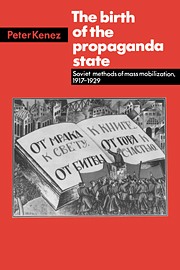Introduction: The Soviet concept of propaganda
Published online by Cambridge University Press: 02 December 2009
Summary
This book is about the development of Bolshevik propaganda. The subject is an important one, because propaganda played a large role in the 1917 victory of the Communists and an even greater part in their ability to retain power during the extremely difficult years of the 1917–1921 Civil War. In the course of the relatively peaceful 1920s, the revolutionary leadership attempted to transform man and society through mass indoctrination.
The subject also deserves careful study because the institutions of mass mobilization became integral parts of the Soviet system. As we examine how the Leninists saw their task of bringing their message to the workers and peasants and how they built their institutions of indoctrination, we gain essential insights into the Russian form of Marxism.
Furthermore, the Soviet Communists were pathbreakers; they introduced a new approach to politics. In the course of the twentieth century, revolutionaries in various parts of the world often found themselves in a situation similar to that of the Bolsheviks in the early part of their rule. Their solutions to problems frequently mirrored Bolshevik solutions. This was not so much because of any conscious copying, though that also happened, but because circumstances dictated essentially similar approaches. The Bolshevik leadership in the Civil War period and in the 1920s was made up of intelligent and articulate people. It is of enduring interest how they defined their problems and how they arrived at their solutions.
The development of Soviet propaganda is an elusive and difficult subject. The greatest problem is that while we all think we know perfectly well what propaganda is, in fact we have no precise definition that would be value free and valid regardless of time or political culture.
- Type
- Chapter
- Information
- The Birth of the Propaganda StateSoviet Methods of Mass Mobilization, 1917-1929, pp. 1 - 18Publisher: Cambridge University PressPrint publication year: 1985



